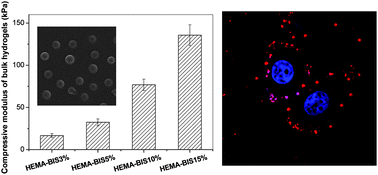News
| Uptake of hydrogel particles with different stiffness and its influence on HepG2 cell functions |
| Time:2012-08-09 16:18 Source:未知 Author:polymer Click: |
The interactions between colloidal particles and cells are of paramount importance for understanding the potential safety issue of the particles, which in turn provide the design principles of various carriers for biomedical applications. In this study, the influence of particle stiffness on cellular uptake and cell functions are elucidated. Four types of poly(2-hydroxyethyl methacrylate) (HEMA) hydrogel particles with different amounts of crosslinking agent, N,N′-methylene-bis-acrylamide (BIS), and thereby compressive modulus (from 15–156 kPa) were synthesized by an emulsion–precipitation polymerization. All of the particles had a diameter of 800–1000 nm in water. Although the softer particles were slightly swollen in the cell culture medium, the particle sizes were still similar. Adsorption of proteins (35 mg g−1particles) occurred on all the particles, leading to a change of zeta potential from −20 mV (in water) to −5 mV (in serum containing medium). However, the particle size and surface charge property were not significantly changed. The softer particles were internalized by HepG2 cells at a faster rate and larger amount than the stiffer particles. Cellular uptake mechanisms were clarified by the addition of inhibitors to specific endocytosis pathways. The influence of the particle uptake on cell toxicity and functions were then studied in terms of cell viability, morphology and cytoskeleton organization, and cell adhesion. Uptake of all types of the particles did not cause an apparent decrease of cell viability and alteration of cell morphology, but changed the cytoskeleton organization to some extent. The cell adhesion ability was significantly affected, especially after uptake of the stiffer particles.
Weijun Liu, Xiangyan Zhou, Zhengwei Mao, Dahai Yu, Bing Wang and Changyou Gao
Soft Matter, 2012, Advance Article, DOI: 10.1039/C2SM26001H |

